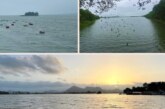 NEW DELHI: Despite projections of a hot summer ahead, there’s one good reason why north India may not face a major water crisis at least over the next two months — very good snowfall in the western Himalayas.
NEW DELHI: Despite projections of a hot summer ahead, there’s one good reason why north India may not face a major water crisis at least over the next two months — very good snowfall in the western Himalayas.
From J&K to Uttarakhand, the region received its highest snowfall this year in many seasons. Himachal Pradesh recorded 25-year-high snowfall in the January to March period, according to the state met department. Uttarakhand too had its best snowfall since 2014, as per data from the state met department’s lone snow gauge in Mukteshwar, which recorded more snow in the past three months than in the past four years put together.
Winter precipitation (rain and snow) in Srinagar and Jammu was the second-highest in the past decade while in arid Leh, it was the highest since at least 2009. These figures point to good accumulation of snow in the high mountain reaches, which are the sources of nearly all rivers in north India.
“There’s around 13 feet of snow in the Kedarnath region this year while around this time last year, we had found snow just fourfive feet deep,” said D P Dobhal, a veteran glaciologist at the Wadia Institute of Himalayan Geology.
Dobhal said the difference goes beyond the higher depth of snow this year. Since snow this year had accumulated over many episodes over the season, it has had time to compact and turn into ice. “Four-five feet of snow melts fast when temperatures rise but 13 feet will take a much longer time because of its hardness and the role of higher snowfall in lowering temperatures in these regions,” the expert said.
“This much snow will melt over a period of at least two months. So, one can expect good discharge in Himalayan rivers till June, around the time the monsoon arrives. This is non-permanent snow we are referring to. The perennial glaciers too will be positively impacted by the higher snowfall,” Dobhal said.
A 2015 hydrological modelling study on Sutlej river using remote sensing as well as on-ground data showed that snow melt accounts for 35% of the river’s annual discharge at the mountain front, followed by 10% from glacier melt. Rainfall, most of it during the monsoon months, accounts for the rest 55% of river discharge.
Snowfall this winter was in sharp contrast to last year. The breakdown of the polar vortex around the North Pole in late December impacted large scale weather currents, which made western disturbances (WDs) that strike north India, more intense. In the subsequent months of January and February, 14 WDs struck northern India, against a normal of 10-12, bringing snow and rain in the hills.
“Even in the lower reaches such as Shimla, snowfall this year was five times higher than last winter,” said Manmohan Singh, head of the state met department. The impact of all that snow will continue to be felt in the coming summer months.
By Amit Bhattacharya



